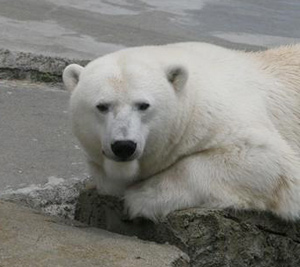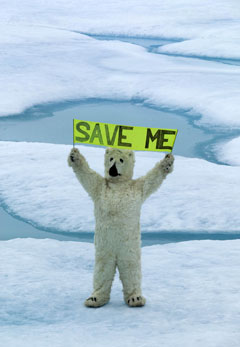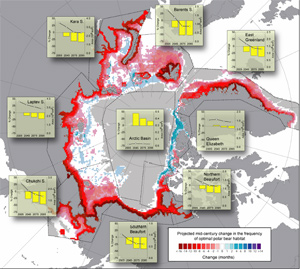Two-thirds of polar bears at risk of extinction by 2050
Two-thirds of polar bears at risk of extinction by 2050
mongabay.com
September 7, 2007
Two-thirds the world’s polar bears could be threatened with extinction by 2050 due to melting sea ice resulting from global warming, said U.S. government scientists Friday.
U.S. Geological Survey biologists said the United States (the north coast of Alaska) and Russia will likely lose all of their polar bear populations due to thinning and disappearing sea ice. The only bears expected to survive would be those in northern Canadian Arctic islands and the west coast of Greenland. Overall, bears are forecast to lose 42 percent of the Arctic range they need to hunt and breed during summer months.
“Projected changes in future sea ice conditions, if realized, will result in loss of approximately two-thirds of the world’s current polar bear population by the mid 21st century,” states the report, one of nine separate reports on polar bears issued by USGS Friday.

Courtesy of the U.S. Fish and Wildlife Service |
The studies comes as research from National Oceanic and Atmospheric Administration scientists that shows summer sea ice off Alaska’s north coast will likely shrink to nearly half the area it covered in the 1980s by 2050. The paper, to be published tomorrow in Geophysical Research Letters, compared 20 computer models from the United Nations’ Intergovernmental Panel on Climate Change (IPCC) with observations from 1979 through 1999. It found that the ice-free area off the north coast of Alaska could reach 300 to 500 miles by 2050.
Also this week, the National Snow and Ice Data Center released figures showing the extent of Arctic sea ice had fallen to 4.75 million square miles — or 300,000 square miles below the previous record low of 5.05 million square miles in September 2005. The Arctic is particularly sensitive to changes in the extent of sea ice, which helps reflect sunlight back into space, cooling the region. When sea ice melts, the dark areas of open water absorb the sun’s radiation, trigger a positive feedback loop that worsens melting.

Photo by R. Butler |
This April research published in Geophysical Research Letters warned that Arctic sea ice is melting about three times faster than previously believed. The study, conducted by Julienne Stroeve of the National Snow and Ice Data Center (NSIDC) and his colleagues, showed that September sea ice extent retreated at a rate of about 7.8 percent per decade during the 1953-2006 period, not the 2.5 percent projected by simulations. The basis for the data–a combination of satellite measurements and early aircraft and ship reports–is considered more reliable than the earlier records.
Declining sea ice is a major threat to polar bears, which are currently being considered for protection under the Endangered Species Act. A November 2006 study published by scientists from the U.S. Geological Survey and the Canadian Wildlife Service, revealed a 22 percent decline in the size of the western Hudson Bay polar bear population between 1987 and 2004. The research also found that only 43 percent of polar bear cubs in the surveyed area survived their first year, compared to a 65 percent survival rate in the late 1980s and early 1990s. Meanwhile in September 2006, Ian Stirling, a research scientist with the Canadian Wildlife Service, reported that the average weight of adult female polar bears in western Hudson Bay have fallen from 650 pounds in 1980 to just 507 pounds in 2004.
Other reports indicate that drowned polar bears are being found for the first time in Alaska. Researchers speculate that greater distances between ice sheets could be taking a toll on the bears. While bears are capable of swimming long distances–up to 60 miles (100 km) without stopping–it is conceivable that they could suffer from exhaustion during an unexpectedly arduous swim. A shorter spring hunting season caused by progressively earlier breakup of sea ice, reduces the chances of reproductive success for female polar bears.
The loss of ice also makes it more difficult for bears to find food. Unlike grizzly bears, polar bears aren’t adapted to hunting land animals like caribou, instead feeding primarily on seals. However, recent aerial surveys by the U.S. Fish and Wildlife Service show that, over the past five years, polar bears are changing their habits and spending more time on land, congregating on beaches and scavenging whale carcasses. Accordingly, a USGS study published in July reported that polar bears in Alaska are increasingly setting up dens on land because sea ice is thinning. Using satellite telemetry to track the den-making habits of bears in northern Alaska, the scientists found the proportion of dens on ice compared with land fell from 62 percent in the 1985-1994 period to 37 percent between 1998 and 2004. The researchers say that declining quality sea ice makes ice less stable to mothers to raise their cubs. In recent years Arctic sea ice has been forming later and melting earlier, leaving it thinner.

Photo courtesy of Greenpeace |
USGS, which issued reports on three of 19 distinct subpopulations of polar bear, did not estimate precisely how many polar bear would remain 50 years from now. Scientists estimate there are currently 20,000 to 25,000 polar bears world-wide.
Environmentalists say while the outlook for polar bears and other Arctic species — including walrus and 12 species of penguin — is dire, it is not took late to protect wildlife threatened by climate change.
“This grim news about polar bears and sea ice decline is horrifying, but it is a call to action, not despair,” Kassie Siegel of the Arizona-based Center for Biological Diversity told the Associated Press. “The good news is that there is still time to save polar bears. Our hope lies in a rapid response, including both deep and immediate carbon dioxide reductions and a full-court press on other greenhouse pollutants such as methane.”
This article used information from the Associated Press, USGS, and previous mongabay posts.








